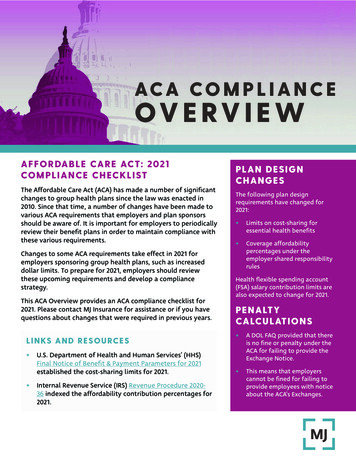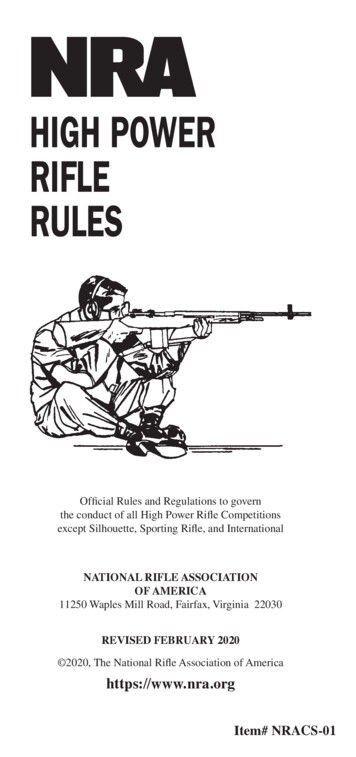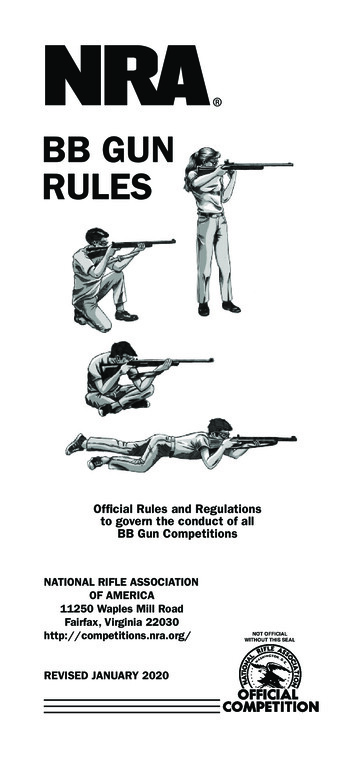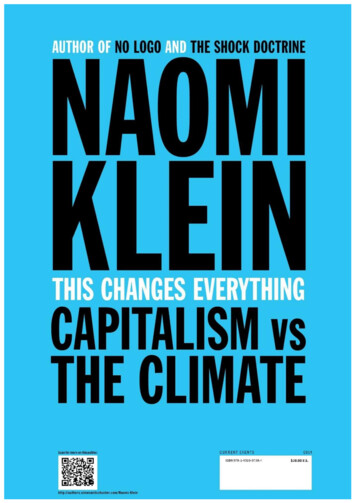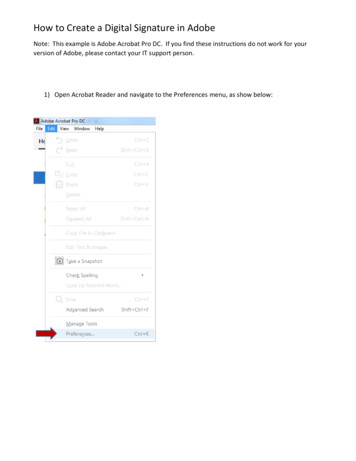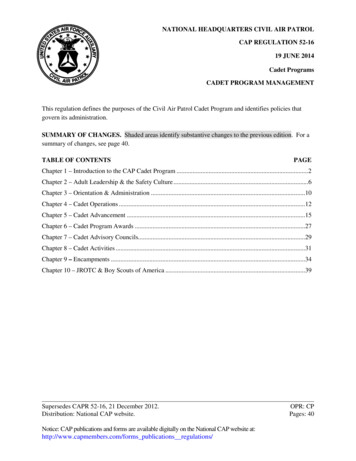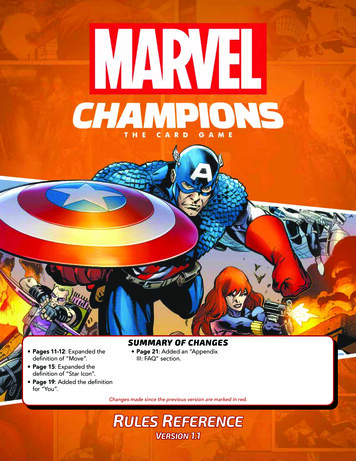
Transcription
Pages 11-12: Expanded thedefinition of “Move”. Page 15: Expanded thedefinition of “Star Icon”. Page 19: Added the definitionfor “You”.SUMMARY OF CHANGES Page 21: Added an “AppendixIII: FAQ” section.Changes made since the previous version are marked in red.Rules ReferenceVersion 1.1
OVE RVI E WG LOSSARYThis document is intended as the definitive source for rulesinformation, but does not teach players how to play thegame. Players should first read the Learn to Play book inits entirety and use this Rules Reference as needed whileplaying the game.The following is an alphabetical list of entries for gamerules, terms, and situations that may occur during play.The majority of this book consists of a glossary, whichprovides an alphabetical listing of terms and situations thatmight be encountered during a game. This section shouldbe the first destination for players with rules questions.The three appendices at the end of the book contain deckcustomization rules, setup rules, and a card anatomy.TH E G O LD E N R U LE SIf the text of this Rules Reference directly contradictsthe text of the Learn to Play book, the text of the RulesReference takes precedence.A BILIT Y, C A RD A BILIT YAn ability is special game text that a card contributes to thegame. Card abilities only interact with cards that are in play,unless the ability specifically refers to an out-of-playarea or element. Card abilities on hero, alter-ego, ally, upgrade, andsupport cards may only be used if the card is in play,unless the ability specifically refers to being usedfrom an out-of-play state. Event cards implicitlyinteract with the game from an out-of-play area, asper the rules of the event card type.If the text of a card directly contradicts the text of either theRules Reference or the Learn to Play book, the text of thecard takes precedence. An ability can only be initiated if its effect couldchange the game. Assess this without accounting forthe consequences of the cost payment or interactionwith other abilities.TH E G R I M R U LE When an ability has more than one sentence of text,the ability is resolved one sentence at a time.If players are unable to find the answer to a rules or timingconflict in this Rules Reference, resolve the conflict in themanner that the players perceive as the worst possibleresolution at that moment with regards to winning thescenario, and continue with the game. An ability prefaced by a bold timing trigger followedby a colon is referred to as a triggered ability. Anability without a bold timing trigger is referred to as aconstant ability.CO M PO N E NT LI M ITATI O N SThere is no limit to the number of threat tokens, damagetokens, status cards, or all-purpose counters that can be inthe game at a given time.If players run out of the provided tokens, counters, or statuscards, other tokens, counters, or coins may be used.ROU N D OVE RVI E WThe following is an overview of a game round, and theglossary entries that cover each part of the game round.1.Player phase begins. See: Player Phase2.Each player takes a turn. See: Player Turn3.Player phase ends. See: End of Player Phase4.Villain phase begins. See: Villain Phase5.Place threat on main scheme. See: Main Scheme6.Villain and minions activate. See: Activation, EnemyAttacks, Enemy Schemes7.Deal encounter cards. See: Deal8.Reveal and resolve encounter cards. See: Reveal9.Pass the first player token. See: First Player The resolution of the following ability types ismandatory: constant abilities, when revealed abilities,when defeated abilities, forced abilities, boostabilities, and keywords. If one of these ability typesuses the word “may,” the part of the ability followingthe word “may” is optional. The resolution of the following ability types isoptional: action, interrupt, response, resource. Theplayer who controls the card that has an optionalability determines whether or not to use that ability atthe appropriate time.See also: Cancel, Constant Ability, Delayed Effects, InPlay and Out of Play, Initiating Abilities, Lasting Effects,Qualifiers, Replacement Effects, Then, Triggered AbilityACCELER ATION ICONSee: Side Scheme10. End the round. Proceed to step one of the next gameround.2Rules Reference
ACCELER ATION TOKENALLYThis token increases the amount of threatplaced on the main scheme during stepone of the villain phase.Ally is a player card type that represents a player’s friends,supporters, or companions. If an ally enters play, it remains in play until a cardability or game effect causes it to leave play. If anally’s remaining hit points are reduced to zero, it isdefeated and discarded from play. If the encounter deck runs out ofcards, place one acceleration tokenon the main scheme.See also: Empty Encounter Deck, Main Scheme, VillainPhaseAC TIVATIONIf the villain attacks or schemes, it is considered anactivation. During step two of the villain phase, the villainactivates once per player. If the player resolving theactivation is in hero form, the villain attacks. If theplayer resolving the activation is in alter-ego form,the villain schemes. Some card abilities can also cause the villain to attackor scheme. These are also considered activations. Each time the villain activates, give the villainone boost card from the encounter deck for thatactivation.See also: Boost, Enemy Attacks, Enemy SchemesAC TION“Action” is a type of triggered ability. Players are permittedto trigger action abilities during their turn, or by requestduring other players’ turns.See also: Ability, Player Turn, Triggered AbilityAC TIVE PL AYERThe player taking their turn during the player phase is theactive player.See also: Player Turn After an attack or thwart attempt using an allyresolves, there is often consequential damage thatmust be dealt to the ally, as indicated beneath theally’s ATK or THW field. This damage must be dealtdirectly to the ally. If a player is attacked, any player may exhaust an allythey control to defend against the attack. If an allydefends against an attack, all damage from the attackis dealt to the ally.See also: Ally Limit, Consequential Damage, Hit PointsALLY LIMITEach player is permitted to control a maximum of threeallies in play at any given time. This is referred to as the“ally limit.”AT TACHMENTAttachment is an encounter card type.When an attachment enters play, it attaches to another cardor game element. If an attachment attaches to the villain, it may modifythe villain’s ATK and/or SCH values, as indicated bythe values in the associated fields on the attachmentcard.See also: Attach ToAT TACH TOA F TERThe word “after” refers to a game occurrence that justconcluded. Many response abilities use the term “after” tospecify the time at which they can be used.See also: ResponseALL-PURPOSE COUNTERIf a card uses the phrase “attach to,” it must be attached to(placed beneath and slightly overlapped by) the specifiedgame element as it enters play. Once a card is attached, it remains in play until eitherthe element it is attached to leaves play (in whichcase the attached card is discarded) or an ability orgame effect causes the attached card to leave play. An attached card exhausts and readies independentlyof the game element it is attached to.All-purpose counters can be used to track avariety of different game states and statuses.They have no inherent rules.Card abilities can create and define a number of differentcounter types, such as “arrow counters” or “web counters.”If a counter is called for, an all-purpose counter is used totrack its presence in the game.See also: Keywords (Uses) During a player’s turn, they may use any number ofallies they control to attack or thwart. An ally mustexhaust to pay the cost of being used in this way. The “attach to” phrase is checked for legality whenthe card would be attached to a game element, but itis not checked again after it is attached. If the initial“attach to” check does not pass, the card is not ableto be attached, so it remains in its prior state or gamearea. If such a card cannot remain in its prior state orgame area, discard it.Rules Reference3
AT TACK After applying a boost card to an activation, discard it.Some game effects and card abilities reference an attack.There are a few different ways an attack can occur: A hero can use their basic attack power to attack anenemy. A hero must exhaust to use this power. Thisdeals damage equal to the hero’s ATK value to theenemy.ATTACHMENTenhanCed ivoRy hoRn An ally can use its basic attack power to attack anenemy. This deals damage equal to the ally’s ATKvalue to the enemy. If a triggered ability is labeled as an attack—suchas “Hero Action (attack)”—resolving that ability isconsidered to attack the specified target. Unlessspecified by the ability’s text, a hero does not exhaustwhen using such an ability. Hero and ally attacks can target any enemy, unless acard ability (such as guard) is preventing that enemyWEAPON.from being attacked.AttachtocanRhino. Enemiesattack during step two of the villainphase.HeroAction: Spend Card abilities can cause the villain and/or minions toresources discardthis card.attack at othertimes if the abilityexplicitly instructsthe villain or minion to “attack.” 1AT KSee also: Enemy Attacks, Enemy Schemes, Star IconC A NCELSome card abilities can cancel card or game effects. Cancel abilities interrupt the initiation of effects andprevent them from initiating. Anytime the effects of an ability are canceled, theability (apart from its effects) is still regarded asinitiated, and any costs are still paid. Only the effectsare prevented from initiating, and do not resolve. If the effects of an event card are canceled, the cardis still considered played, and it is discarded. If the effects of a treachery card are canceled, thecard is still regarded as revealed, and it is still placedin the encounter discard pile.See also: AbilityC A NNOTThe word “cannot” is absolute and cannot becountermanded by other abilities or effects.See also: Enemy AttacksC A RD T Y PESBA SE VALUEThe game’s card types are: ally, attachment, environment,event, identity (hero and alter-ego), main scheme, minion,obligation, resource, side scheme, support, treachery,upgrade, and villain.A defined value before modifiers are applied. In most cases,it is also the printed value.See also: Modifiers, X)the villain attacks or schemes, MARVEL 2019 FFG card fromthe villain is givenone facedownthe encounter deck, as a boost card. 100Boost I consDuring the activation (and after anydefenders are declared if the villain isattacking), all boost cards on the villain are turned face upone at a time. Add the number of boost icons on the card tothe villain’s ATK value (if it is attacking) or SCH value (if it isscheming) for that activation. Boost icons are located at thebottom-right of the card.If the boost field has a star icon, it indicates that the cardhas a boost ability. Refer to the card’s text box and resolvethe boost ability when the card is turned face up. The boostability is located beneath the divider line in the text box. A star icon is not itself considered a boost icon, anddoes not contribute to the villain’s ATK or SCH value. Only the ability text beneath the divider line is activeon a card that is resolving as a boost card. If additional boost cards are resolved for anactivation, the boost icons are cumulative, and allboost abilities on those cards resolve. If an ability causes a card to change its card type,it loses all other card types it might possess andfunctions as would any card of the new card type.See also: Appendix III: Card AnatomyCH A R AC TERHeroes, alter-egos, allies, villains, and minions are allcharacters.CHOOSEThe word “choose” indicates that a player must make achoice to resolve an ability. The player resolving the ability that uses the word“choose” is the player who makes the choicespecified by the card. While making such a choice, the player must make achoice that could change the game, if able. If there is no valid choice for resolving the ability, theability cannot be initiated.CONFUSE , CONFUSEDIf an ability “confuses” a character, give that character aconfused status card.See also: Status Cards4Rules Reference
CONSEQUENTIAL DA M AGEDA M AGEAfter an ally attacks, it takes consequential damage equal tothe number of pips beneath its ATK field.Damage reduces a character’s hit points. Ifa character has zero or fewer remaining hitpoints, it is defeated.After an ally thwarts, it takes consequential damage equalto the number of pips beneath its THW field.CONSTA NT A BILIT YA constant ability is any non-keyword ability whose textcontains no bold timing trigger defining its ability type. Aconstant ability becomes active as soon as its card entersplay and remains active while the card is in play. Some constant abilities continuously seek a specificcondition (denoted by words such as “during,” “if,”or “while”). The effects of such abilities are activeanytime the specific condition is met. If multiple instances of the same constant abilityare in play, each instance affects the gameindependently.CONTROLSee: Ownership and ControlCOSTA card’s resource cost is the numerical value that must bepaid to play the card. Some abilities have a cost describedin the ability text that must be paid to usethe ability. An arrow icon ( ) in ability text distinguishes a costfrom an effect, in a “pay cost resolve effect”format. While paying a cost, a player is permitted to generateresources beyond the specified cost. Any resources that are generated beyond a requiredcost are lost after paying the cost. Damage on a hero/alter-ego or villain is tracked on ahit point dial. If such a character is damaged, reduceits dial by the amount of damage that it took. Damage on an ally or minion is tracked by damagetokens. If such a character is damaged, place thespecified value of damage tokens on the character.See also: Defeat, Hit Points, Indirect Damage, Move, PreventDA SHIf a character’s power (ATK, THW, REC, etc.) has a dash (–) asthe value, the character cannot exhaust to use that power.DE AL , DE AL A N ENCOUNTER C A RDDuring step three of the villain phase, each player is dealtone facedown encounter card.If a card ability instructs a player to be dealt an encountercard, the player takes the top card of the encounter deckand places it facedown in front of them. This card is notrevealed at this time. This card is added to the queue ofcards that player resolves during the villain phase. If a player is dealt an encounter card during stepthree or four of the villain phase, the extra encountercard is added to the queue of cards that are beingdealt and revealed in those same steps.See also: Villain PhaseDEFE ATIf a character has zero or fewer remaining hit points, or if aside scheme has no threat on it, it is defeated. If a card is defeated, it is discarded. If multiple costs for a single card or ability requirepayment, those costs must be paid simultaneously.See also: Hit Points, Player Elimination, Villain Defeat An ability’s cost cannot be paid if the resolution ofthat ability’s effect could not change the game state.DEFEND, DEFENSE While a player is paying a cost, that player must paycosts with cards and/or game elements they control.Some game effects and card abilities reference defense.There are a few different ways a defense can occur:See also: Ability, Initiating Abilities, Keywords A hero can use their basic defense power to defendagainst an attack. A hero must exhaust to use thispower. The amount of damage dealt by the attack isreduced by the hero’s DEF value, and any remainingdamage is dealt to the defending hero.COUNTER An ally can exhaust to defend against an attack.Damage from the attack is dealt to the ally. If a cost requires a game element that is not inplay, the player paying the cost may only use gameelements that are in their own out-of-play areas.See: All-Purpose CounterCRISIS ICONSee: Side Scheme If a triggered ability is labeled as a defense—such as“Hero Interrupt (defense)”—resolving that ability isconsidered a defense. Unless specified by the ability’stext, a hero does not exhaust when using such an ability. If a player defends an attack (against another player)with a card they control, that player becomes the newtarget of the attack.Rules Reference5
DEL AYED EFFEC T SEND OF PL AYER PH A SESome abilities contain delayed effects. Such abilities specifya future timing point, or indicate a future condition that mayarise, and dictate an effect that is to happen at that time.To end the player phase, perform the following steps:1. Delayed effects resolve automatically andimmediately after their specified timing point orfuture condition occurs or becomes true, and beforeresponses to that point or condition may be used.In player order, each player may discard any number ofcards from their hand, and must discard down to theirhand size if they have more cards than their hand size.2.Each player simultaneously draws up to their hand size.3.Each player simultaneously readies all of their cards. When a delayed effect resolves, it is not treated as anew triggered ability, even if the delayed effect wasoriginally created by a triggered ability.ENEMYDR AWING C A RDSIf a player is instructed to draw one or more cards, thosecards are drawn from the top of their deck.If a player draws two or more cards as the result of asingle game step or card ability, those cards are drawnsimultaneously.Drawn cards are added to a player’s hand.Each player’s hand size is checked at the end of the playerphase. If a player has more cards in their hand than theirhand size value at this time, they must choose and discardcards from hand until they are at their hand size.EFFEC TSee: Ability, CostAn enemy is a minion or villain.When used as a descriptor, “enemy” refers to gameelements that belong to the scenario: “enemy cards,”“enemy abilities,” etc.ENEMY AT TACK STo resolve an enemy attack, follow these steps:1.If a villain is attacking, give it one facedown boost cardfrom the encounter deck. (If a minion is attacking, skipthis step.)2.If a player wishes to defend, that player exhausts a heroor ally as the defender. If a player other than the targetplayer defends, the defending player becomes thetarget player for this attack.3.If a villain is attacking, flip each of the villain’s boostcards faceup one at a time, and increase the villain’sATK value by one for each boost icon on the card.Resolve any boost effects, indicated by the star icon inthe boost field, after the card is flipped faceup. Discardeach boost card after it is resolved. (If a minion isattacking, skip this step.)4.Deal damage from the attack equal to the attackingvillain or minion’s modified ATK value, based on thefollowing:EMP T Y ENCOUNTER DECKIf the encounter deck runs out of cards, the encounterdiscard pile is immediately shuffled to create a newencounter deck. An acceleration token is placed next tothe scheme deck. This token places an additional threat onthe main scheme each round, during step one of the villainphase. If all cards from the encounter deck are discardedwhile an ability is looking for a specified card, theability fails to find the card, the deck reshuffles, anacceleration token is placed, and the game continues.No cards are discarded from the newly shuffled deck.See also: Acceleration TokenEMP T Y PL AYER DECKIf a player deck runs out of cards, the player shuffles theirdiscard pile to make a new deck. That player immediatelydeals themself one card from the encounter deck.If the player’s draw deck empties and reshuffles while theplayer was drawing cards, the player continues to drawcards up to the specified number. If this happened while theplayer was discarding cards from their deck, no cards arediscarded from the newly shuffled deck. If a hero defends the attack, the amount of damagedealt is reduced by that hero’s DEF value, and theremaining damage from the attack is dealt to thathero. If an ally defends the attack, all damage from theattack is dealt to the ally. (If the ally is defeated by theattack, additional damage does not carry over to thehero.) If no character defends the attack, the attack isconsidered undefended. All damage from the attackis dealt to the hero that is resolving this activation.See also: Activation, Boost, Defend, Villain PhaseSee also: Deal6Rules Reference
ENEMY SCHEMESIf an enemy is instructed to scheme, follow these steps:1.If a villain is scheming, give it one facedown boost cardfrom the encounter deck. (If a minion is scheming, skipthis step.)2.If a villain is scheming, flip each of the villain’s boostcards faceup one at a time, and increase the villain’sSCH value by one for each boost icon on the card.Resolve any boost effects, indicated by the star icon inthe boost field, after the card is flipped faceup. Discardeach boost card after it is resolved. (If a minion isscheming, skip this step.)3.Place threat on the main scheme equal to the schemingvillain or minion’s modified SCH value.See also: Activation, Boost, Villain PhaseENG AGEDIf a minion enters play, it engages a player, and is placed infront of that player’s play area.Unless otherwise specified by the minion or by the effectthat put the minion into play, the minion engages the playerwho is resolving the current encounter card. An engaged minion remains engaged with the sameplayer until it is defeated, removed from play, or acard ability causes it to engage another player.ENTERS PL AYThe phrase “enters play” refers to any time when a cardtransitions from an out-of-play area into play. Playing a card,putting a card into play by using a card ability, or revealinga card from the encounter deck are all different means bywhich a card may enter play.See also: Play, Put Into Play, RevealENVIRONMENTEnvironment is an encounter card type that creates anoverarching rule or set of rules for the scenario.An environment card enters play next to the villain, and isactive so long as it remains in play. If an environment enters play, it remains in play until acard ability or game effect causes it to leave play.E VENTEvent is a player card type that is generally played for aninstantaneous effect.Each time a player plays an event card, its costs are paid,its effects resolve (or are canceled), and the card is placedin its owner’s discard pile after those effects resolve (or arecanceled). If the effects of an event are canceled, the card is stillconsidered to have been played, and its costs remainpaid. Only the effects are canceled. Playing an event card from hand is always optional fora player, unless the event uses the word “must” in itsplay instructions. An event card cannot be played unless the resolutionof its effect (ignoring costs) could change the game.E XH AUSTEDIf a card is exhausted, it is rotated 90 degrees. An exhausted card cannot be exhausted again until itis ready. Cards are typically readied by a game stepor card ability. A card ability on an exhausted card is active andcan still interact with the game state. However, if anexhausted card must exhaust to pay the cost of usingits ability, that ability cannot be used until the cardis ready.See also: ReadyFIRST PL AYERA first player is determined by the players at the beginningof the game.The first player token is used to indicate which player isthe first player. At the end of the round (during step five ofthe villain phase) the first player token passes to the nextclockwise player, who becomes first player for the nextround.If the first player is eliminated, the first player tokenimmediately passes clockwise to the next player.The players as a group are encouraged to work together,but the first player decides the following: If an encounter card targets a specific player or card,and there are multiple eligible targets, the first playerselects among the eligible options. If two or more effects would resolve simultaneously,the first player decides the order in which to resolvethem.The first player has timing priority in the following situations: The first player has the first opportunity to usean interrupt at each appropriate game moment.Interrupt opportunities then proceed among theremaining players in player order. The first player has the first opportunity to usea response at each appropriate game moment.Response opportunities then proceed among theremaining players in player order.See also: In Player OrderRules Reference7
FORCEDGE T SForced is a bold trigger word. If the word “Forced”precedes a triggered ability, the ability’s initiation ismandatory.If a card ability causes a character to “get” a statistic (suchas 1 ATK or 4 hit points), the ability modifies the character’sstatistic while it is active. For any given triggering condition, forced interruptstake priority and initiate before non-forced interrupts,and forced responses take priority and initiate beforenon-forced responses. If two or more forced abilities would initiate at thesame moment, the first player determines the order inwhich the abilities initiate, regardless of who controlsthe cards bearing those abilities. Each forced ability must resolve as completelyas possible before the next forced ability beingtriggered by the same triggering condition mayinitiate. If such an ability causes a character to get hit points,it modifies the character’s remaining hit pointswhile the ability remains active, and also modifiesthe character’s maximum hit points while the abilityremains active.GUA RDSee: KeywordsSee also: Triggered AbilityH A ND SIZEFORM, CH A NGE FORMEach player checks their hand size at the end of the playerphase, either discarding down to or drawing up to thenumber of cards indicated by their hand size value.A player can be in either hero or alter-ego form at a giventime. This is indicated by the player’s identity card. Once each round, during their turn, each player ispermitted to change form by flipping their identitycard. When a player changes form, only the form changes.The character retains their sustained damage, statuscards, lasting effects, attachments, tokens, andcurrent state (ready or exhausted). If a card ability causes a player to change forms,it does not count against the one voluntary formchange the player is permitted during their turn thatround. While a player is in hero form, card abilities thatinteract with their alter-ego do not interact withtheir identity. While a player is in alter-ego form, card abilitiesthat interact with their hero do not interact withtheir identity.See also: IdentityFriendly is a blanket term that refers to cards the playerscontrol.G A INSIf a card gains a characteristic (such as a trait, keyword, orability text), the card functions as if it possesses the gainedcharacteristic. Gained characteristics are not considered tobe printed on the card.GENER ATESee: ResourceSee also: End of Player PhaseH A Z A RD ICONSee: Side SchemeHE ALIf an ability heals a character, damage the character hassustained can be removed from the character. A heal effect can only bring a character to itsmaximum hit points, unless the effect explictly statesit can bring the character above its maximum.See also: Gets, Hit PointsHIT POINT SEach character (hero/alter-ego, ally, minion, and villain) hasa hit point value. Hit points represent the durability of thatcharacter. If a hero/alter-ego or villain is damaged, apply thedamage by reducing its hit point dial by the specifiedamount.FRIENDLY8 If such an ability expires or otherwise becomesinactive, the modified statistic reverts to the value itwould have without the modifier. If a player’s hit point dial is reduced to zero, thatplayer has been defeated and is eliminated from thegame. (See Player Elimination.) If a villain’s hit point dial is reduced to zero, that stageof the villain has been defeated. (See Villain Defeat.) If a minion or ally is damaged, track the damage byplacing damage tokens on the card. Damage tokenson a card reduce the card’s remaining hit points bythe total value of the tokens. An ally or minion withzero or fewer remaining hit points is defeated andplaced in the appropriate discard pile. (See Defeat.)See also: Damage, Gets, Heal, Maximum Hit Points,Remaining Hit Points, Sustained DamageRules Reference
IDENTIT YINDIREC T DA M AGEIdentity is a player card type that represents which charactera player is playing in the game.Some card abilities may deal “indirect damage.”A player’s identity card is a double-sided card thatrepresents their hero on one side and their alter-ego on theother. The side that is face up indicates the form (hero oralter-ego) that player is currently in. Each player begins the game in alter-ego form. If a card refers to a hero or alter-ego by title, it refersonly to the identity with that title, and not to theother side of the card.See also: FormIN PL AY A ND OUT OF PL AYNon-event cards that have been played or put into play are“in play” until a card ability or other game effect removesthem from play. The top card of the villain deck and the topcard of the main scheme deck are also in play.Cards in a player’s hand, deck, and discard pile, as well ascards in the encounter deck, encounter discard pile, andunrevealed cards in the villain deck and the main schemedeck are out of play. Any cards that have been removedfrom the game or that have been set aside are also out ofplay.Indirect damage dealt to a player or group of players mustbe split among all characters that the specified player(s)control(s). While assigning indirect damage, a charactercannot be assigned more indirect damage than would causeit to be defeated.INITIATING A BILITIES,PL AY ING C A RDSWhen a player wishes to play a card or initiate a triggeredability, that player first declares their intent. Then, the playerchecks the following conditions in order:1.Check play restrictions: can the card be played, or theability init
enemy. A hero must exhaust to use this power. This deals damage equal to the hero's ATK value to the enemy. An ally can use its basic attack power to attack an enemy. This deals damage equal to the ally's ATK value to the enemy. If a triggered ability is labeled as an attack—such as "Hero Action (attack)"—resolving that .





